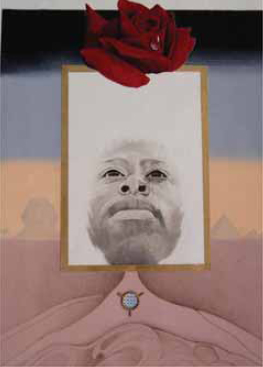
VERO BEACH — A former graduate of what was Vero Beach’s pre-integration black high school, Gifford High, has returned to Vero Beach with a retrospective collection of his artwork on view at the Vero Beach Museum of Art.
“The Grid Turns the Corner, a Mid-Career Retrospective of Drawings and Prints by Terry K. Hunter” is more than a retrospective of one man’s artistic career. It is a cultural and socio-political tour of life in the U.S. from the early 1970s to today. From the Vietnam War to the Civil Rights Movement, this exhibition is a powerful educational experience, a dramatic reminder of a tumultuous time. The exhibition, comprising 20 pieces of a 52-piece touring exhibition, will be at the Vero Beach Museum of Art through Jan. 3.
Now residing in Orangeburg, S.C., where he has lived since 1977, Hunter, who holds a Ph.D. in art education from Florida State University, graduated from Gifford High School in 1971. He was the keynote speaker at Gifford High School’s 40th reunion earlier this month. Hunter was the class valedictorian.
The same year that Hunter graduated, Gifford High School was integrated with Vero Beach High School. The coinciding of the two events — Hunter’s museum exhibition and his class’s 40th reunion, gave the community a chance to celebrate his extraordinary accomplishments as an artist and teacher.
Hunter, who teaches at South Carolina State University, was born in Tallahassee in 1951. His parents, Samuel and Audrey Hunter, were both educators. In 1965, Hunter and his family moved to Gifford where his father became principal of Gifford High School. In 1971, Samuel Hunter became the first African American county-wide school administrator in Indian River County.
A strong influence in Hunter’s teens was Willie C. Reagan, the head of the art department at Gifford High and a member of the group of local artists known as the Highwaymen. A graduate of Florida A & M, Reagan impressed upon Hunter the idea of being an artist as educator, and an educator as artist. The idea clicked.
Along with choosing a career while in high school, Hunter also met his future wife, Gilda Yevette Cobb. In fact, Cobb, as Hunter calls her, was one of the first people to appreciate his art. She would become a central figure in a striking number of his works.
“Cobb was one of the very, very few who actually got it about this art stuff,” says Hunter. “I sometimes think that her recipe became, ‘the way to this man’s heart is through his art.'”
It was a groundbreaking time-the ’70s. In 1972, Shirley Chisholm, the first African-American and the first woman to run for president was going up against George Wallace on the Democratic ticket. A 1975 TV show called Starsky and Hutch showed an African-American boss of white Americans for the first time, and the novel Roots: The Saga of an American Family by Alex Haley became a runaway best seller.
Enter Terry K. Hunter, a 1973 graduate of Florida A & M University in Tallahassee, embarking on his life’s work. Today, Hunter holds a master of fine arts degree in printmaking and drawing from Ohio State University and a Ph.D. in art education from Florida State University. Hunter is the Executive Director of FACETS, the Fine Arts Cultural Enrichment Teaching Studios in Orangeburg, SC.
Searching for a way to address his angst at the era, Hunter was impressed by Op Art in the late 1960’s and 70s. He also began drawing the human figure and portraits. And he became fascinated with printmaking, seeing it as a powerful tool for social commentary.
While pursuing his graduate fine arts degree at Ohio State, Hunter was studio assistant to Sydney Chafetz, head of the printmaking department, who played a key role in the evolution of Hunter’s thinking.
“Syd…was probably the first to recognize my passion for wanting to use art as a platform for my social voice,” says Hunter.
Chafetz pointed Hunter in two directions. First, he suggested that Hunter turn to his own culture for inspiration and use history as a platform upon which to build. At Chafetz’s urging, Hunter enrolled in an African-American art history class.
Second, Chafetz directed Hunter to study two artists in particular: Kathe Kollwitz (1867-1945) the German Expressionist printmaker and sculptor and Francisco Goya (1746-1828) the Spanish painter and printmaker.
Regarding Goya, Hunter says, “From beautifully understated morality plays to horrific displays of man’s inhumanity to man, the works moved me in a way no others had done. Even more interesting was the fact that the works were done in black and white. This would prove to be very significant to my development of the current direction in my work with the grid.”
Starting in the early 1980s, Hunter began developing a unique way of working, one that allowed him to use a myriad of artistic techniques.
He begins by drawing a grid on white paper. Using crushed charcoal mixed with India ink, he layers images over and over, spraying Krylon matte fixative to set each finished layer before continuing to the next.
As he puts in place a layer of images at a time, Hunter uses many methods to achieve the desired multidimensional effect. He outlines the images with white Prismacolor. He highlights by erasing and airbrushes in different images where he wants them. He superimposes figures, buildings and urban landscapes over the basic framework of a grid. In this way, Hunter builds rich layers of images that possess real depth and draw the viewer in.
The exhibition began its tour at Florida A & M University in Tallahassee. It will travel to Clemson University, the Piccolo/Spoleto Festival in Charleston, Ohio State University, Columbia College in Columbia, S. C. and to South Carolina State University in Orangeburg, South Carolina.






